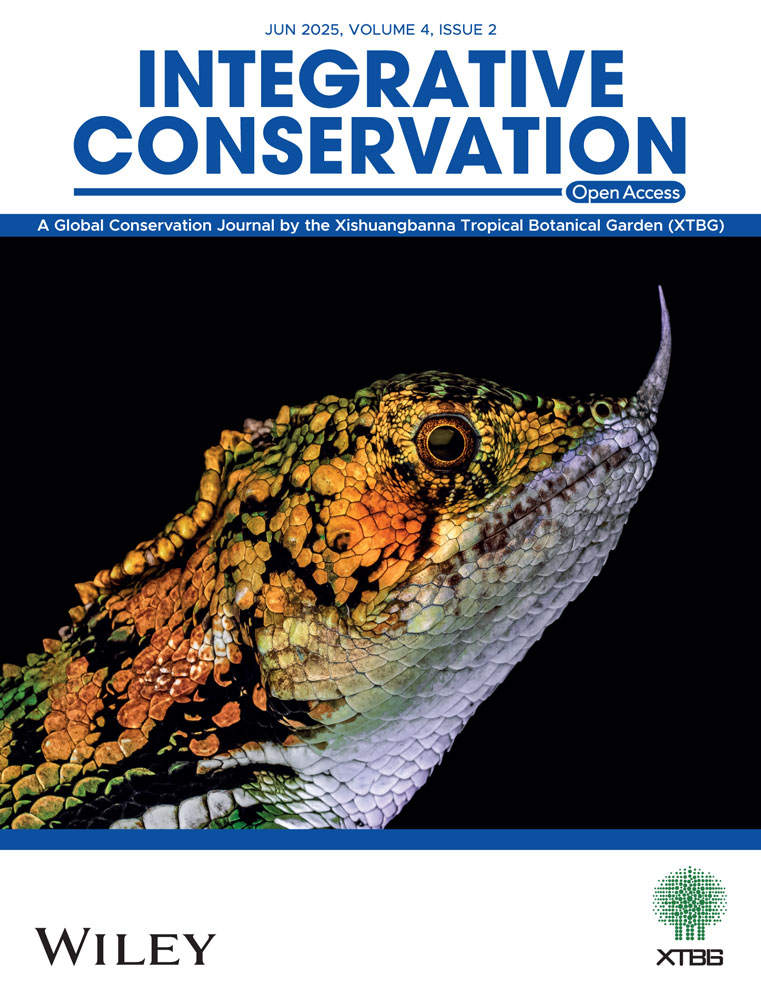The Primate Name Yòu (狖) and Its Referents: Implications for the Future Conservation of François' Langurs in China
灵长类动物名称“狖”及其指代对象再钩沉: 对中国黑叶猴 (Trachypithecus francoisi) 未来保护的启迪
Editor-in-Chief & Handling Editor: Ahimsa Campos-Arceiz
ABSTRACT
enRethinking traditional animal names and their referents throughout history is important for understanding indigenous knowledge of wildlife, defining the role of animals in traditional cultures, and potentially promoting the conservation of species. The character yòu (狖) was the name of a nonhuman primate in ancient China. To date, yòu has been considered a gibbon (Nomascus spp.), a snub-nosed monkey (Rhinopithecus spp.), or a François' langur (Trachypithecus francoisi). To better understand its original identity, I analyzed additional evidence to revisit the ideas and referents associated with yòu. Overall, identifying yòu as François' langurs is more consistent with historical archives. Historical records reveal that Fraznçois' langurs were widely distributed across South China in earlier periods. However, the species has since become extirpated from most of its primary habitats in the country. Reintroducing captive individuals into areas where François’ langurs were once found may be a key conservation strategy for restoring locally extinct populations and safeguarding this endangered species in the future.
摘要
zh重新思考历史演变中的传统动物名称及其指代对象对于准确理解野生动物的本土知识、更好解读动物在传统文化中的作用至关重要, 可能有助于推动物种的保护。汉字“狖”是古代中国的一种灵长类动物的名字。截止目前, 它被认为代指黑冠长臂猿属物种 (Nomascus spp.) 或金丝猴属物种 (Rhinopithecus spp.) 或黑叶猴 (Trachypithecus francoisi) 。为了更好地辨析其原始指代对象, 笔者对更为丰富的证据进行了分析, 重探了狖的指称与指称对象。结果表明古代文本中“狖”的原始身份最有可能为黑叶猴。同时, 历史记录揭示出在早期黑叶猴曾广泛分布于中国南方地区。但是随着时间推移, 该物种在中国已从其原有的绝大多数栖息地消失。未来将圈养个体重引入那些黑叶猴曾经分布的区域可能是恢复局部灭绝种群和拯救该物种的一项关键保护策略。
通俗摘要
zh动物的传统名称及其指代对象对于历史动物地理学研究具有启发意义。汉字“狖”是中国古代一种灵长类动物的名称。当下, 科学家与许多公众普遍认为这个名称指代金丝猴属动物 (Rhinopithecus spp.) 。在历史语言背景下, 本文通过对丰富证据的深入剖析, 重新探索了“ 狖”这一名称的观念和指代对象。笔者发现了古时“狖” 的最初且更加准确的语义值:狖为“黑猿”, 即黑叶猴 (Trachypithecus francoisi)。换而言之, “狖”的主流指代对象在历史进程中, 已从黑叶猴转变为了金丝猴。正如本研究所证明的, 在历史时期, 黑叶猴曾广布于中国的南方地区。不幸的是, 如今该物种在中国仅见于重庆市、贵州省和广西壮族自治区的部分孤立区域。因此, 在黑叶猴曾经分布的区域开展圈养个体的野外放归工作, 或将是未来拯救这一濒危物种的有用策略。
实践者要点
zh
-
相较金丝猴 (Rhinopithecus spp.) 或黑冠长臂猿 (Nomascus spp.), 黑叶猴 (Trachypithecus francoisi)更加可能是汉字“狖” 的原始指代对象。
-
历史记录揭示在较早时期, 黑叶猴曾经广泛分布于中国南方地区。
-
将黑叶猴圈养个体重引入至历史栖息地或将是未来拯救这一濒危物种的有用策略。
Summary
enTraditional animal names and their referents have implications for historical zoogeography. The character yòu (狖) was the name of a nonhuman primate in ancient China. Today, this name has often been interpreted as referring to snub-nosed monkeys (Rhinopithecus spp.) by scientists and members of the public. In this study, I analyzed additional evidence to revisit the meanings and referents of yòu in the context of historical language. I found the original and more accurate semantic value of yòu in ancient times refers to the black yuán (猿) or François' langur (Trachypithecus francoisi). In other words, the mainstream referent of the word yòu appears to have shifted from François' langurs to snub-nosed monkeys over time. As evidenced by this study, François’ langurs were widely distributed in South China in historical periods. Unfortunately, the species currently survives only in a few isolated areas in China, including Chongqing, Guizhou Province, and Guangxi Province. Hence, reintroducing captive individuals in regions where François' langurs were once found may be a useful strategy to conserve this endangered species in the future.
-
Practitioner Points
- ∘
François' langur (Trachypithecus francoisi) is more likely to be the original referent of the character yòu (狖) than the snub-nosed monkey (Rhinopithecus spp.) or gibbon (Nomascus spp.).
- ∘
Historical records reveal that François' langurs were widely distributed in South China in earlier periods.
- ∘
Reintroducing captive individuals into areas where François' langurs were once distributed could be an important strategy to conserve this Endangered species in the future.
- ∘
Conflicts of Interest
The author declares no conflicts of interest.
Open Research
Data Availability Statement
The author has nothing to report.




